 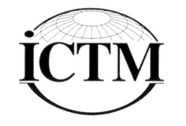
Yearbook for Traditional Music, Vol. 33, 2001
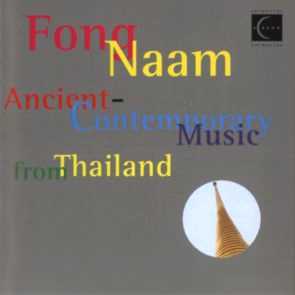
 14098 ANCIENT-CONTEMPORARY
MUSIC FROM THAILAND (2 CD) - FONG
NAAM
14098 ANCIENT-CONTEMPORARY
MUSIC FROM THAILAND (2 CD) - FONG
NAAM
Fong Naam: Ancient-Contemporary Music from Thailand. Celestial
Harmonies. 14098-2. Annotated by Bruce Gaston. 20 pages of notes in
English. Musical notation. 2 discs (Disc I: 7 tracks; Disc II: 8 tracks).
Recorded in concert and in the studio. 131.49. 1995.
The title of this CD gives the clue to its intentions. Fong Naam has
attempted to present an encyclopedic range of music in order to make
what is old, fresh, and what is newly created, resonant with the ancient
past. The purpose, according to the notes, is to provide a "Practical
Guide for the Development of Thai Listening Skills" for outsiders.
Fong Naam is a group of Thai musicians brought together by an American
named Bruce Gaston to stimulate interest in Thai music in Thailand and
around the world. It is a core group around which many guest musicians
gather for specific projects. On this CD, Bruce Gaston's ambitions are
high. The liner notes are very scholarly and informative. With written
educational back–up, he takes the listener from music which is
so old, the origins are lost (Royal Lullaby and Cherd Nai),
through historical Thai compositions (The Chinese Doctor's Puzzle),
right up to pop music inspired by traditional pieces (Busaba's Votive
Candle) and contemporary compositions in the Thai classical style
(The Maiden Plays in the Water Overture).
The result is a triumph: fresh, highly accomplished, carefully recorded
and mastered, and thoroughly enjoyable for Thai and Westerner alike.
I recommend it both for the first time listener and the connoisseur,
which is a rare achievement.
Yearbook for Traditional Music, Vol. 33, 2001

 13134 TEMBANG SUNDA: CLASSICAL
MUSIC FROM WEST JAVA - IDA WIDAWATI/LINGKUNG SENI MALATI
13134 TEMBANG SUNDA: CLASSICAL
MUSIC FROM WEST JAVA - IDA WIDAWATI/LINGKUNG SENI MALATI
Tembang Sunda: Classical Music from West Java. Celestial Harmonies.
13134-2. Produced by David Parsons. Annotated by Andrew Weintraub. 14
pages of notes in English. 1 colour map, 1 colour photograph. 9 tracks
recorded in a studio. 71.36. 1996.
Tembang Sunda is the collective name for Sudanese aristocratic song,
accompanied by large and small boat–shaped zithers (kacapi
and rincik, respectively) and a bamboo flute (suling).
In only the past 5 years, half a dozen compact disc recordings of this
important regional style have been released, and this recording well
represents this style. With some of the most often performed sings in
two of the three common tuning systems, the disc could easily be used
to represent a typical evening performance of tembang sunda.
The primary performer, Ida Widawati, is a very well–known singer
with awards and many recordings to her credit. Her instrumentalists
all do a fine job of supporting her on this recording; they work well
together and hold tempos steady throughout. Although the recording lacks
the crystal clarity of some compact discs, its warmth more closely duplicates
the sound of an Indonesian recording. Andrew Weintraub's liner notes
are excellent, written with an insider's knowledge and just the right
blend of theoretical and contextual information to make the work useful
to a diverse audience. In particular, his explanations of the individual
songs are very helpful.
Yearbook for Traditional Music, Vol. 33, 2001
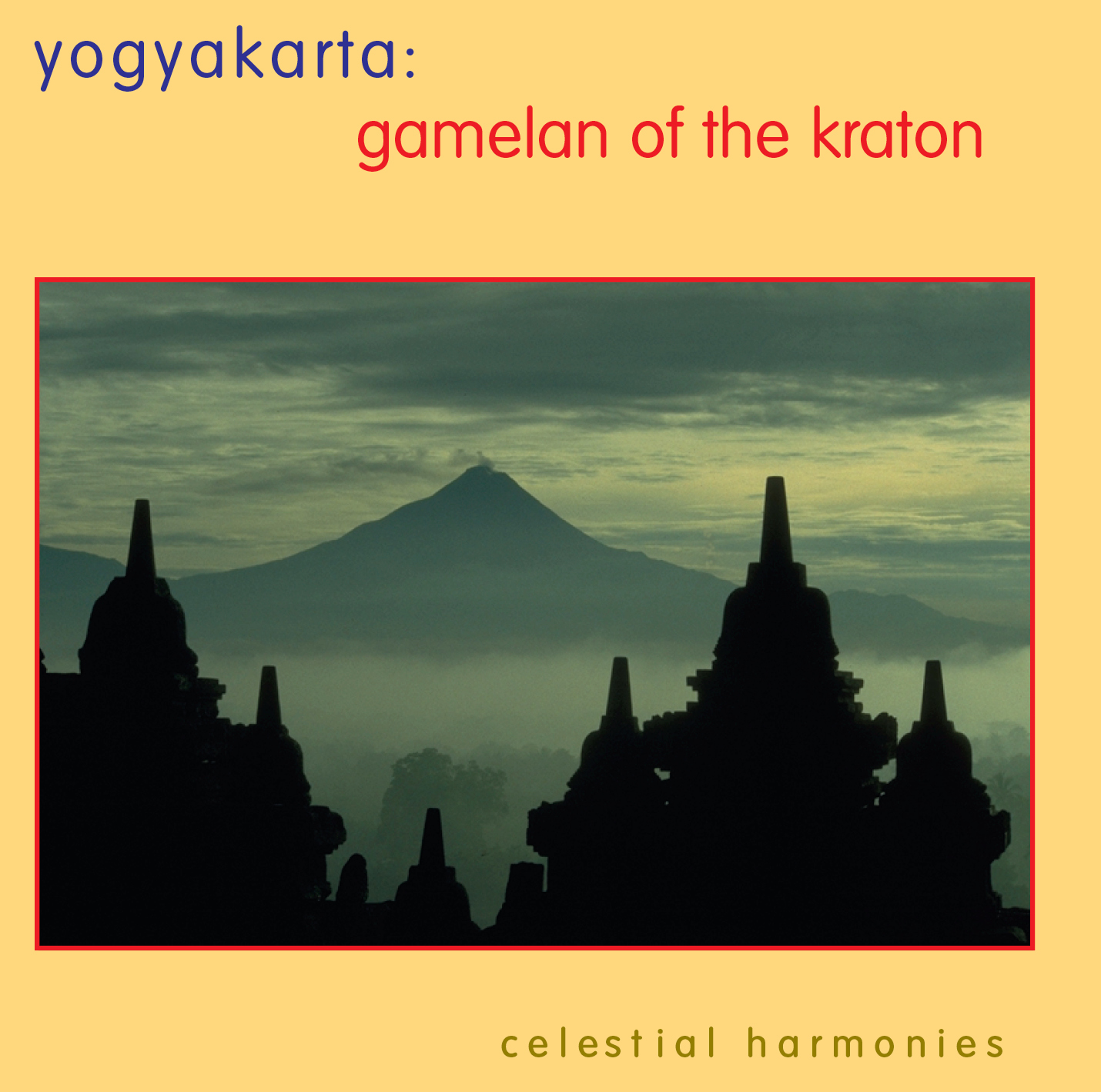
 13161 YOGYAKARTA: GAMELAN
OF THE KRATON - KAWEDANAN HAGENG PUNAKAWAN - KRIDO
MARDAWA
13161 YOGYAKARTA: GAMELAN
OF THE KRATON - KAWEDANAN HAGENG PUNAKAWAN - KRIDO
MARDAWA
Yogyakarta: Gamelan of the Kraton. Celestial Harmonies. 13161-2.
Recorded by David Parsons. Annotated by Roger Vetter. 26 pages of notes
in English. Colour photographs. 4 tracks recorded in the field. 63.45.
1997.
This CD features four compositions played by one of the gamelan
orchestras of the Sultan of Yogyakarta in Central Java (Indonesia).
It comes with a handsome 26–page booklet, written by Java–specialist
Roger Vetter, containing excellent notes, addressing the historical,
cultural and musical context.
The quality of this recording, which emphasises the loud (soran)
style of gamelan playing, is superb; David Parsons did an excellent
job in capturing the complicated sound characteristics of the gamelan
instruments.
Track #1 (genhing lintang kaharinan) is a great example of the
rich texture that results from playing interlocking and anticipatory
patterns. Thanks to the good quality of the recording, the listener
should have no problem identifying the different musical layers. Track
#2 (ladrang semingan) is a lighter and livelier piece, derived
from tayuban, a social tradition. The last track (ladrang
liwung) is a short, vigorous piece that serves as a nice conclusion.
At almost thirty–five minutes, track #3 (srimpi pandhelori)
is the centrepiece of the disc. This court dance features a sequence
of vocal and instrumental sections in different tempos. The march–like
segments (ladrang gati) which frame the dance are extraordinary
because of the addition of Western brass instruments and snare drums.
The only shortcoming of this CD is the fact that it lacks an inventory
of the featured musical instruments, nor do we know which gamelan
Parsons recorded. However, the quality of the recording and the accompanying
notes make this CD much more valuable than most of the poorly documented
CDs that flood the market. This is a must–have for novice and expert.
Yearbook for Traditional Music, Vol. 33, 2001
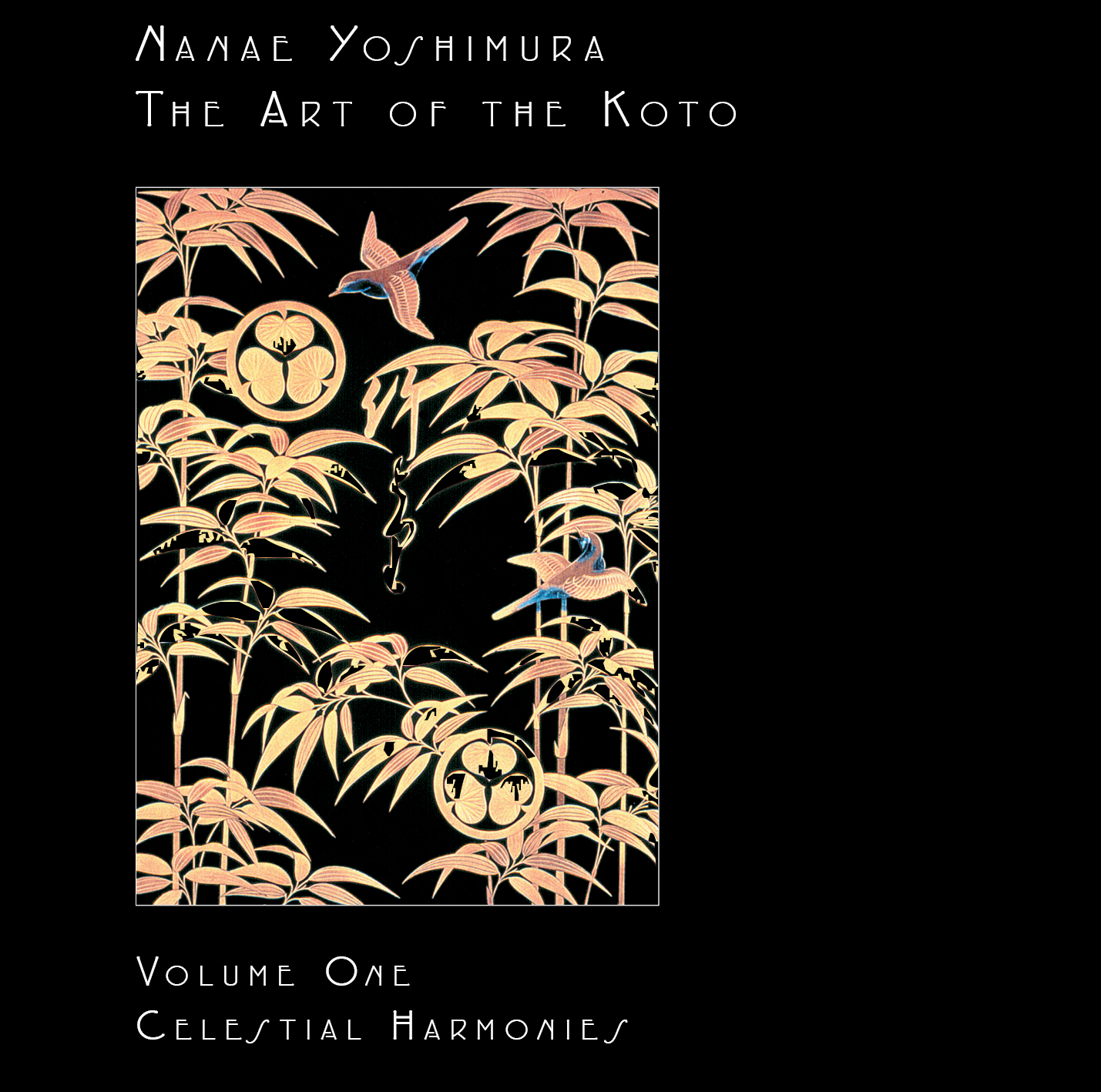
 13186 THE ART OF THE KOTO, VOLUME
ONE - NANAE YOSHIMURA
13186 THE ART OF THE KOTO, VOLUME
ONE - NANAE YOSHIMURA
The Art of the Koto, Volume One. Celestial Harmonies. 13186-2.
Performed and produced by Nanae Yoshimura. Annotated and translated
by Steven G. Nelson. 24 pages of notes in English. 1 colour photograph.
No bibliography. 5 tracks recorded in the studio. 52.83. 2000.
The first recording of a four-volume series, The Art of the Koto,
Volume One offers an overview of the classical koto repertoire
of Japan's Edo period (1600-1868). It contains five compositons that
are representative of the danmomo, jiuta, and tegotomono
styles that became popular in the Kyoto and Osaka areas from the seventeenth
through the nineteenth centuries. While the five pieces Rokudan,
Midare, Zangetsu, Godan Ginuta and Chidori
appear frequently on compilations of koto "classics"
or "favourites", this recording is by no means redundant.
Rather, by listening to this CD and comparing it to some of those other
recordings, one can gain real insight into an important dimension of
koto aesthetics: style.
Like other collections of classical koto music, this CD begins
appropriately with Rokudan and Midare. They are attributed
to Yatsuhashi Kengyo, the "father of solo koto music." Yoshimura
performs these pieces, as well as Chidori, solo. She is joined
by Satomi Fukami on Zangetsu (Fukami performs shamisen)
and on Godan Ginuta (Fukami performs koto).
The liner notes present a comprehensive introduction to koto, encompassing
its history, construction, and tuning systems. They also provide an
impressively broad context for the compositions on the CD, situating
them at the intersection of history, geography, society and politics.
The annotations even describe how these pieces relate to other genres
and instrumental traditions (biwa, shakuhachi and kokyu)
of the time.
Yearbook for Traditional Music, Vol. 33, 2001
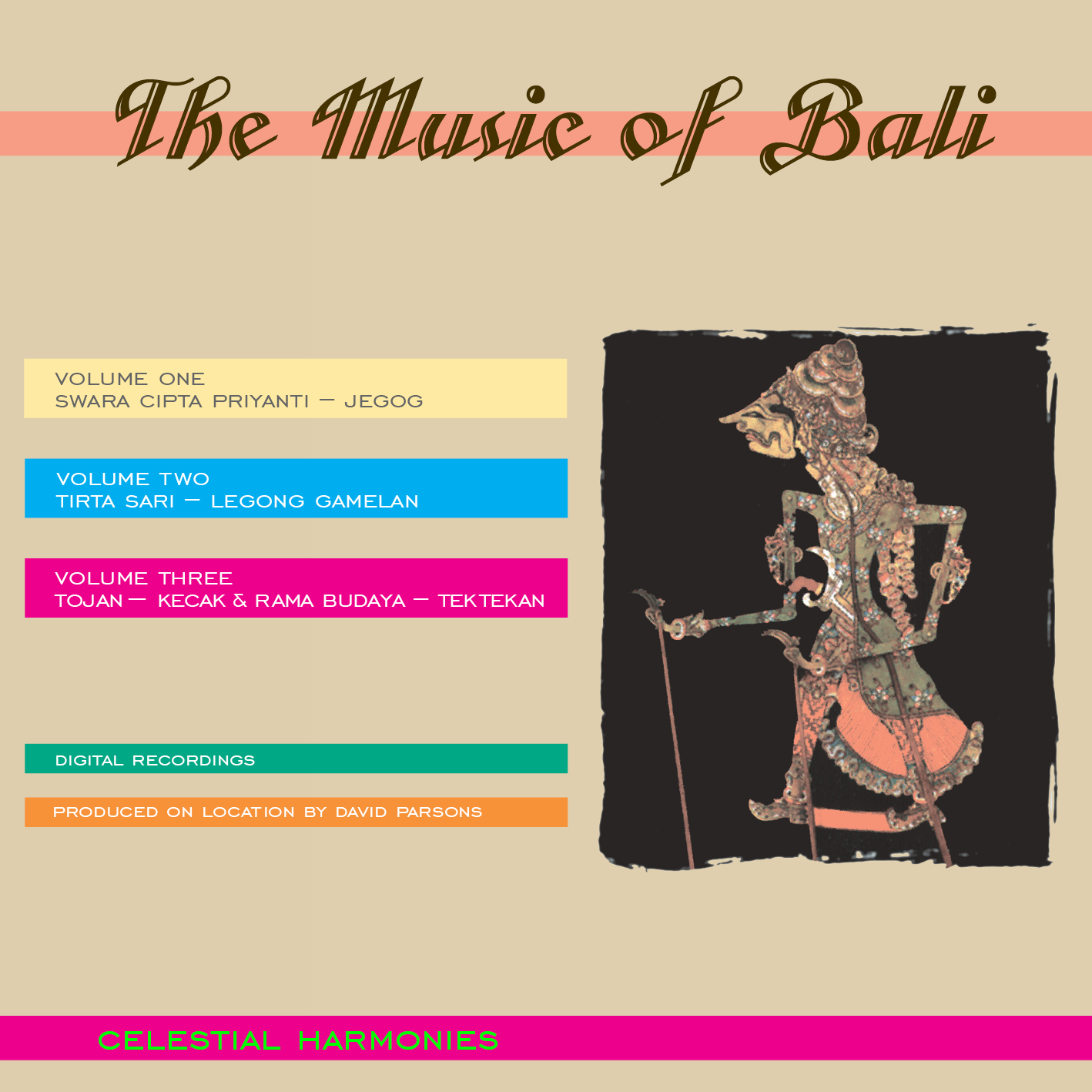
 19905 THE MUSIC OF BALI (3
CD BOXED SET) - VARIOUS ARTISTS
19905 THE MUSIC OF BALI (3
CD BOXED SET) - VARIOUS ARTISTS
The Music of Bali. Celestial Harmonies. 13136-2 to 13138-2.
Recorded by David and Kay Parsons. Annotated by Andrew N. Weintraub
and Wayne Vitale, with Kate Bedall as consultant on Vol. 1. 1997.
Vol. 1. Swara Cipta Priyanti - Jegog. (13136)
15 pages of notes in English. 5 colour photographs. 3 tracks recorded
in the Pura Penataran Temple. 68.30.
Vol. 2. Tirta Sari - Legong Gamelan. (13137)
24 pages of notes in English. 9 colour photographs. 8 tracks recorded
in the Pura Gunung Sari Temple. 69.30.
Vol. 3. Tojan - Kecak and Rama Budaya-Tektekan. (13138)
12 pages of notes in English. 6 colour photographs. 2 tracks recorded
in the Pura Gunung Sari Temple and the Pura Penataran Temple. 68.14.
This three–CD box set covers a diverse range of Balinese genres
and styles. Volume One features three selections played on the bamboo
idiophone–dominated gamelan jegog; Volume Two, somewhat
misleadingly subtitled Legong Gamelan, in actuality comprises
a set of popular classics drawn from the legong and kebyar
repertories, which are performed here by the Tirta Sari gamelan group,
arguably the most well–known of all Balinese gamelan clubs. Volume
Three is divided roughly equally betweeen a kecak and a tektekan
performance, the former highlighting the ever–popular "vocal
gamelan" (gamelan suara) style for which it is famous, the
latter moving into the less heavily charted terrain of a type of processional
gamelan that features interlocking patterns played on a small slit–drums
(tektekan) together with a beleganjur-like ensemble of
drums, cymbals, and gongs (see Bakan 1999: 102).
The Music of Bali is a welcome addition to a growing body of Balinese
music recordings released in recent years. All of the selections were
digitally recorded at Balinese temple sites. The recording quality and
production values are uniformly high. The quality of the performances
themselves, which feature respected Balinese groups, is also very good
overall, although there is an interesting disparity in levels of performance
ability between different ensembles. At one end of the spectrum is Tirta
Sari, whose virtuosity and precision are almost uncanny; at the other
end is the Rama Budaya tektekan group, whose performance is marked
by loose interlocking drumming, mushy cymbal unisons, and slippery tempos.
While any number of "tighter" tektekan groups might
have been selected, Rama Budaya's presence here is refreshing, bringing
to life the "sound of the street," which is as much a part
of the Balinese musical soundscape as the more polished musical fare
of groups like Tirta Sari that dominates most commercial recordings.
Each of the three CDs is accompanied by its own booklet. The notes,
by Andrew Weintraub and Wayne Vitale (with Kate Beddall on Volume One),
are accurate and informative. The Volume Two booklet, which includes
an individual annotation for each of the eight selections, is especially
helpful. In contrast, the booklets for Volume One and Three provide
more generic discussions of the gamelans and genres represented, without
getting into specifics about actual pieces.
In its entirety, this CD set provides an interesting approach to the
Balinese music "sampler." By limiting each CD to just one
or two types of music and including complete performances of often lengthy
works, producer David Parsons and Balinese co–producer I Nyoman
Dupa have achieved an admirable balance between depth and eclecticism.
As a result, listeners are treated to an interesting array of contrasting
syles, while at the same time getting a chance to really sink their
teeth into each one.
Reference cited
1999 Music of death and new creation: Experiences in the world of
Balinese gamelan Beleganjur. University of Chicago Press.
|



